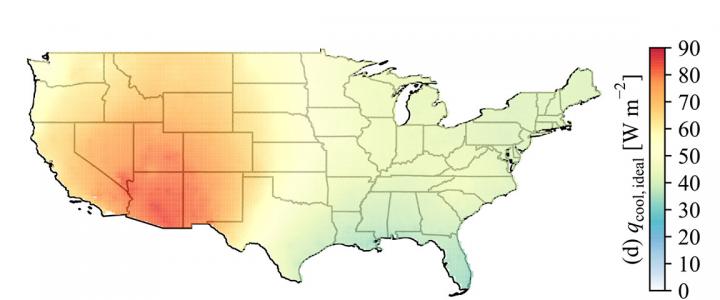If you guessed locations with drier atmospheres and frequent clear skies, you’re right

Credit: Carlos Coimbra
WASHINGTON, D.C., June 25, 2019 — A group of University of California, San Diego researchers set out to gain a better understanding of the thermal balance of power plants and surfaces, like heliostat mirrors or solar panels, when exposed to both solar (shortwave) and atmospheric (longwave) radiation. They quickly realized that they would first need to determine what roles cloud cover and relative humidity play in the transparency of the atmosphere to radiation at temperatures common on Earth.
Determining how much heat can be rejected to outer space and how much is radiated back by the atmosphere to the surface is important when it comes to identifying the exact role water plays. It turns out water, which is present in gaseous, liquid and solid phases within the atmosphere, is not only the main player but also the only atmospheric element that varies rapidly in concentration and isn’t mixed well vertically.
In the Journal of Renewable and Sustainable Energy, from AIP Publishing, the group presents detailed radiative cooling resource maps they created to help determine the best climates for large-scale deployment of passive cooling technologies, which rely on daily changes in temperature and humidity.
“We used recently calibrated correlations, experimental data and models for ground values of water vapor and temperature with sky emissivities to map out the places in the U.S. where we can most effectively reject heat from the ground to outer space,” said Carlos F.M. Coimbra, chair of the Department of Mechanical and Aerospace Engineering. “Because of the physical processes involved, locations with drier atmospheres and the most frequent clear skies are the most appropriate for deploying passive cooling technologies.”
The American Southwest shows great potential, while “other areas where the effect of relative humidity alone depletes the ability to use this cold reservoir resource show much less potential,” Coimbra said. “In the areas with great cooling potential, the total energy consumption and the associated carbon footprint of conventional cooling technologies — often the highest component of electricity demand — can be substantially reduced.”
This work is particularly significant for the area of thermophotonic design of surfaces for passive cooling, which has garnered attention lately due to the potential of rejecting heat to the sky.
“Since antiquity, many societies have used the cold sky to their advantage,” he said. “In desert areas, a clever combination of transpiration cooling (an evaporative method) with passive radiative cooling to ‘cold’ (dry, clear) skies was often used to produce ice and keep it from melting.”
Recent developments in the design of surfaces for specific radiative properties means that exposed surfaces could be coated with paints or other surface treatments — such as specially designed plastics — to substantially improve the ability of these surfaces to reject heat during dry, clear sky conditions during the day or night.
“The design of dry cooling condensers for concentrated solar power plants or air conditioning systems will benefit from the ability to reflect selectivity in the solar while emitting strongly within the infrared parts of the spectrum,” Coimbra said. “But these strategies are most effective during particular seasons and for particular regions of the planet. We live in an era of DNA-targeted medicines, but we still use generic energy technologies that aren’t necessarily tailored to different regional needs. It is time to rethink the way we deploy these impactful technologies.”
###
The article, “Radiative cooling resource maps for the contiguous United States,” is authored by Mengying Li, Hannah B. Peterson and Carlos F. M. Coimbra. It will appear in the Journal of Renewable and Sustainable Energy on June 25, 2019 (DOI: 10.1063/1.5094510). After that date, the article can be accessed at https:/
ABOUT THE JOURNAL
Journal of Renewable and Sustainable Energy is an interdisciplinary, peer-reviewed journal covering all areas of renewable and sustainable energy that apply to the physical science and engineering communities. See https:/
Media Contact
Larry Frum
[email protected]
Related Journal Article
http://dx.




